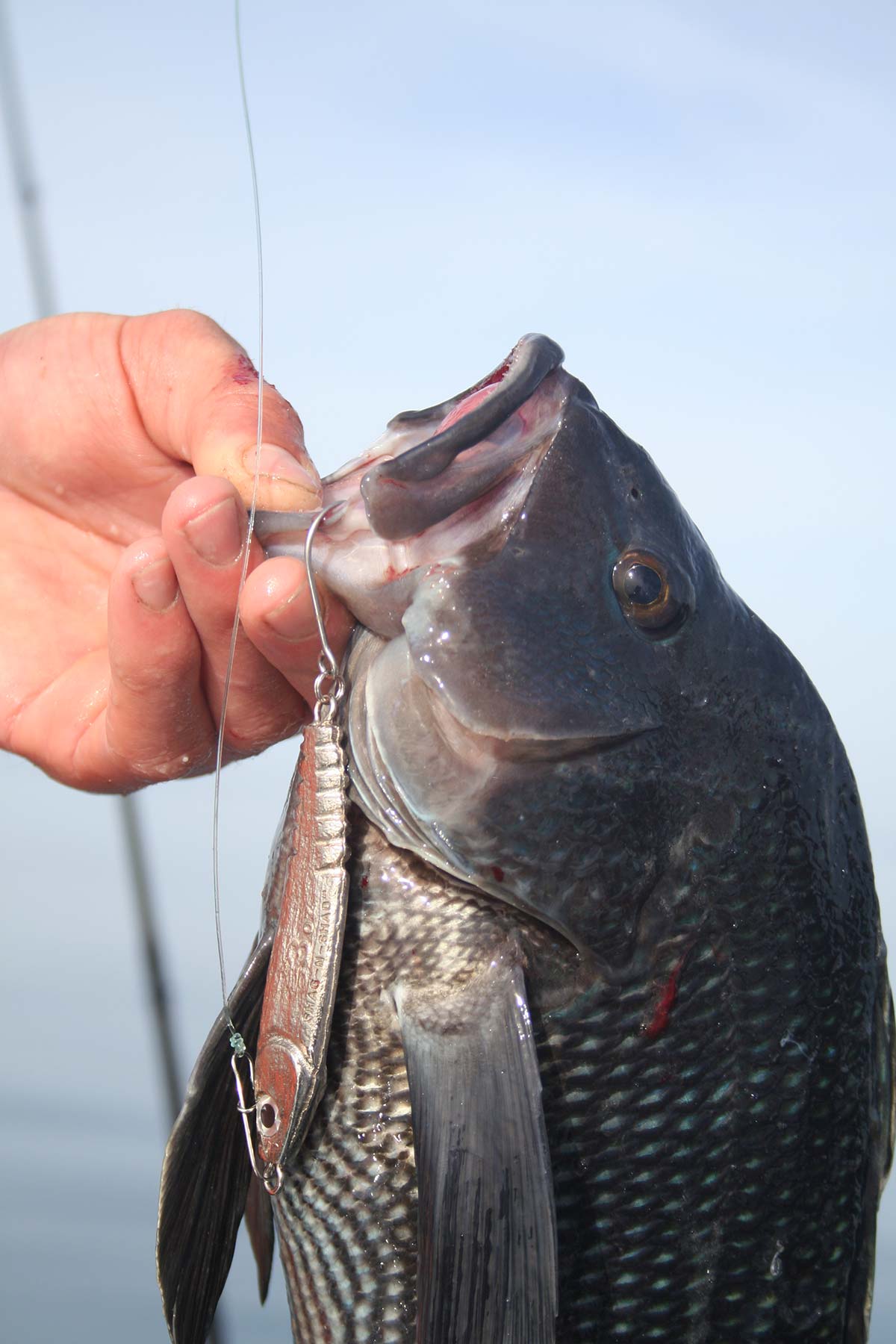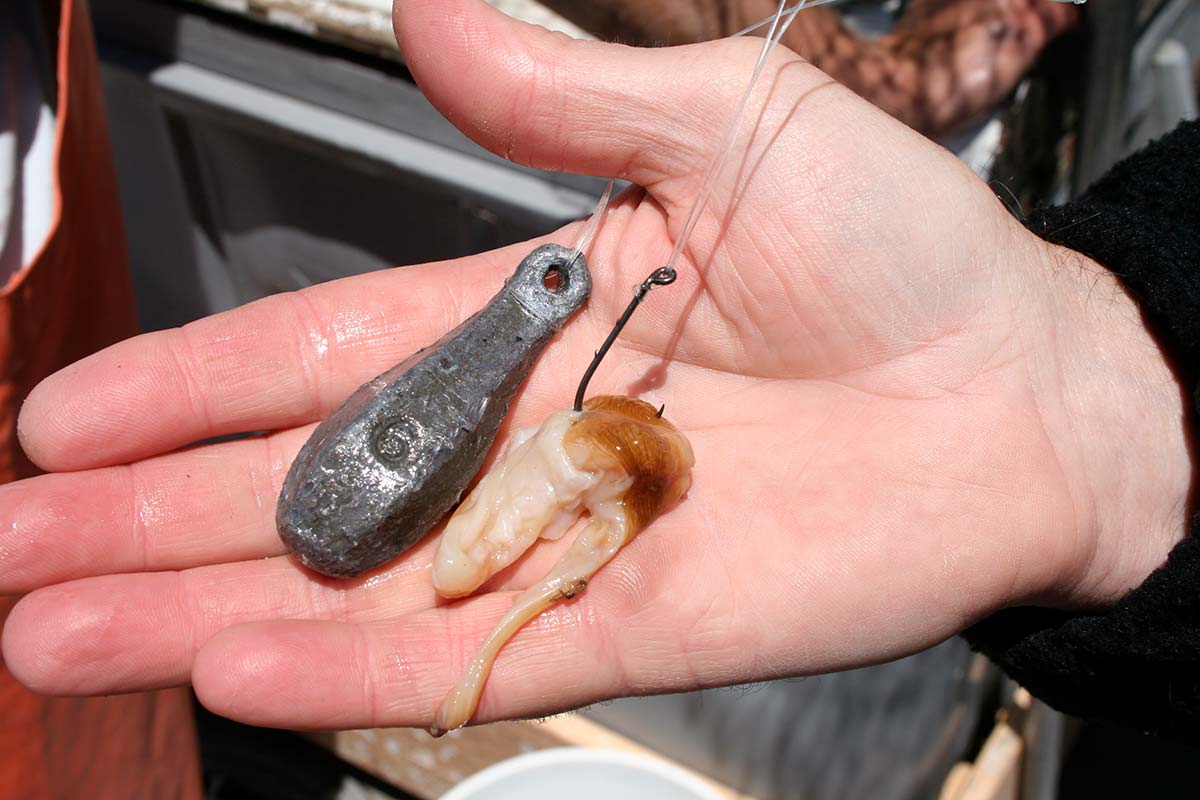
It’s primetime for South Jersey & Delaware sea bassin’
While November brings thoughts of turkey, pumpkin pie and cranberry sauce to most people, those of us who enjoy bottomfishing and eating savory sea bass during the cold days of winter will be out on the ocean catching our heart’s delight this month.
From my perspective down in Delaware, you might think that after being pounded on since May 15 – with a short break in October to satisfy the powers that be at NOAA Fisheries – that there would be few sea bass left to catch at this point.
Fear not, for there should be plenty of them left in November if past experience is any indication of future success.

Days Of Ole
Two years ago, on the Friday after Thanksgiving, my two sons, Ric and Roger and I, went out on a head boat and caught our limit of black sea bass before lunch. We spent the remainder of the day catching keepers and filling limits for those onboard who had less experience with bottomfishing. Ric and Roger fished with various jigs while I stuck with bait; I must admit, the jigs did produce larger fish.
This was far from my first experience with late season sea bass. Many years ago, charter boats used to run cod trips during the winter from Indian River Inlet along the Delaware coast. You paid a flat fee for three or four tub trawls and an additional, I believe it was $50 more, for each extra tub. The tubs had long lines that were let out over smooth bottom and allowed to soak while the party fished the wrecks for sea bass. At the end of the day there were more sea bass in the box than cod.
Those wrecks still hold sea bass. There are any number of them close to Cape May, Lewes and Indian River for anyone to spend a day exploring.
Those who take their own boats out in November will be able to fish smaller structure and find fish that may not have been bothered all year. These wrecks are usually low profile and are too small for most head and charter boats.
The standard method for fishing them has always been to find the structure on you SONAR then mark it with a float. I use a Tide bottle tied to a window sash with 300-pound mono leader. Once the site is marked, I’d run to the bottle and cut the engine. I let my boat drift about 100 yards away from the bottle and take note of the heading. I then run back on the same heading past the bottle and drop my anchor as far away from the bottle as necessary so when I come back on the anchor rode, I will be over the structure.
In my opinion, head and charter boats are the way to go in November. While sunny, calm days are possible and even more common in the past few years, cold winds and 3 to 4-foot seas are the usual greeting you receive once you clear the inlet at Indian River, Lewes or Cape May. I find the warm cabin of a charter or head boat much more comfortable than the open deck of most outboards under such weather conditions.
When booking a fishing trip on a charter or head boat, check the moon phase. Pick days between the full and new moon when the current will be less strong so you won’t need the anchor off the Queen Mary to hold bottom. Also book a couple of days in case bad weather causes you to lose your first or second choices. If you are the one putting together a six-man charter, get the money upfront. If your brother-in-law decides not to get up because it’s too cold, too bad. You have his money and there will be more room on the boat.

Rules Of The Road
If you are new to head boat fishing there are a few rules that should be followed. First be sure you use the same weight as everyone else. The mate should tell everyone what weight to use. If you don’t use that size, you will be tangled with everyone close to you and they will be not your friends. Tangles will happen. When the mate arrives, put your reel in freespool and let him do his job. Don’t try to help. Once he has the lines clear he will tell you to crank your line up.
It doesn’t matter if you fish from a private boat, a charter or a head boat, the tackle you use is going to be pretty much the same. When it comes to bottomfishing I am partial to conventional outfits. The revolving spool reels work much better than fixed spools in this situation because you can control the speed that your line leaves the spool and it is much easier to move the reel from engaged to free spool.
In today’s world braid is the only way to go when bottomfishing. Its thin diameter cuts the resistance to water pressure so less weight is needed than would be required for the same weight in mono line. Braid also has very little stretch so even the slightest nibble is detected by the angler. I feel even more important is the ability to feel the type of bottom you are fishing over. Soft mud, hard sand, metal wreck or rough rocks all feel different.
Braid does not have the abrasion resistance of mono line so I add a shock leader of fluorocarbon line. If I am using 30-pound braid I will use 30- or 40-pound fluoro, at least 6 feet of leader attached to the end of the running line with an Albright or slim beauty knot.
Almost everyone will be fishing a top-bottom rig with some sort of bait. Black sea bass are not picky eaters. I have caught them on squid, clams, crab, Gulp, Fishbites, shrimp and cut bait. I have used all sorts of flashy attractors on my hooks and find plain hooks work just as well. Circle hooks on 6-inch leaders do the best job.

Geared Up
With the current 13-inch size limit on black sea bass (12-1/2 inches in New Jersey waters) I have glued a ruler to the top of my cooler so I can quickly measure my catch. Most head and charter boats have the size limit taped to the rail, but I find that trying to stand while holding on to a flopping fish and then put said fish up to the rail of a boat that is also moving with the waves can be problematic. It is much easier to lay the fish on top of the cooler and get the measurement there.
| SOUTHERN SNAGS |
| The numbers below offer a solid starting point for finding great structure, but try using Captain Segull’s Sportfishing Chart Cape May to Cape Hatteras to find even more wrecks.
Ammo Wreck 38° 52.05 N 74° 23.17 W Champion 38° 54.28 N 74° 10.626 W 28 Mile Wreck 39° 00.38 N 74° 04.95 W Washingtonian 38° 27.42 N 74° 47.18 W T. J. Hooper 38° 26.10 N 74° 23.70 W Misty Blue 38° 45.80 N 74° 19.30 W Lori Dawn 38° 39.39 N 74° 17.40 W There are numerous piece of structure to be found at the Del-Jersey-Land Reef, which is approximately 26 nautical miles from Indian River Inlet and 30 nautical miles from Cape May Inlet. 185’ Atlantic Mist 38° 31.063 N 74° 30.271 W Radford 38° 30.850 N 74° 30.656 W Tamaroa 38° 31.144 N 74° 30.746 W Twin Capes 38° 30.882 N 74° 30.848 W Shearwater 38° 31.661 N 74° 30.607 W |
I mentioned earlier that my sons had used jugs to catch the sea bass when we had our limit. There was nothing fancy or mysterious about the process. Make sure the jig is heavy enough to reach the fish on the bottom. If it is too light it will just take off and never get to the fish. You also don’t want the jig to get tangled with the other anglers on the boat.
I use the same rod and reel that I use for bottomfishing when using a regular jig, though I do have a special rod and reel I use for slow pitch jigging. My bottomfishing rod and reel are Tsunami HYBRID 20 reel on a Tsunami Classic TSCC 761H rod, whereas the slow pitch jig rod and reel are Tsunami FORGED lever drag reel and the Trophy Series TSSSSPJ-C701H rod.
I have used the bottom fishing outfit many times with weights as heavy as 9 ounces and it has preformed flawlessly. I have only tried slow pitch jigging a few times and I did catch sea bass. The problem I have found with jigging is unless everyone around you is doing the same thing tangles are going to happen. If you want to jig on a charter or head boat that is going to anchor the stern would be the best location. If the boat is going to drift then the side where your jig will stream away from the boat will be the best place to fish.
Head boat, charter boat or private boat it doesn’t matter what you go on so long as you go. You can’t catch ‘em watching football on the TV.



